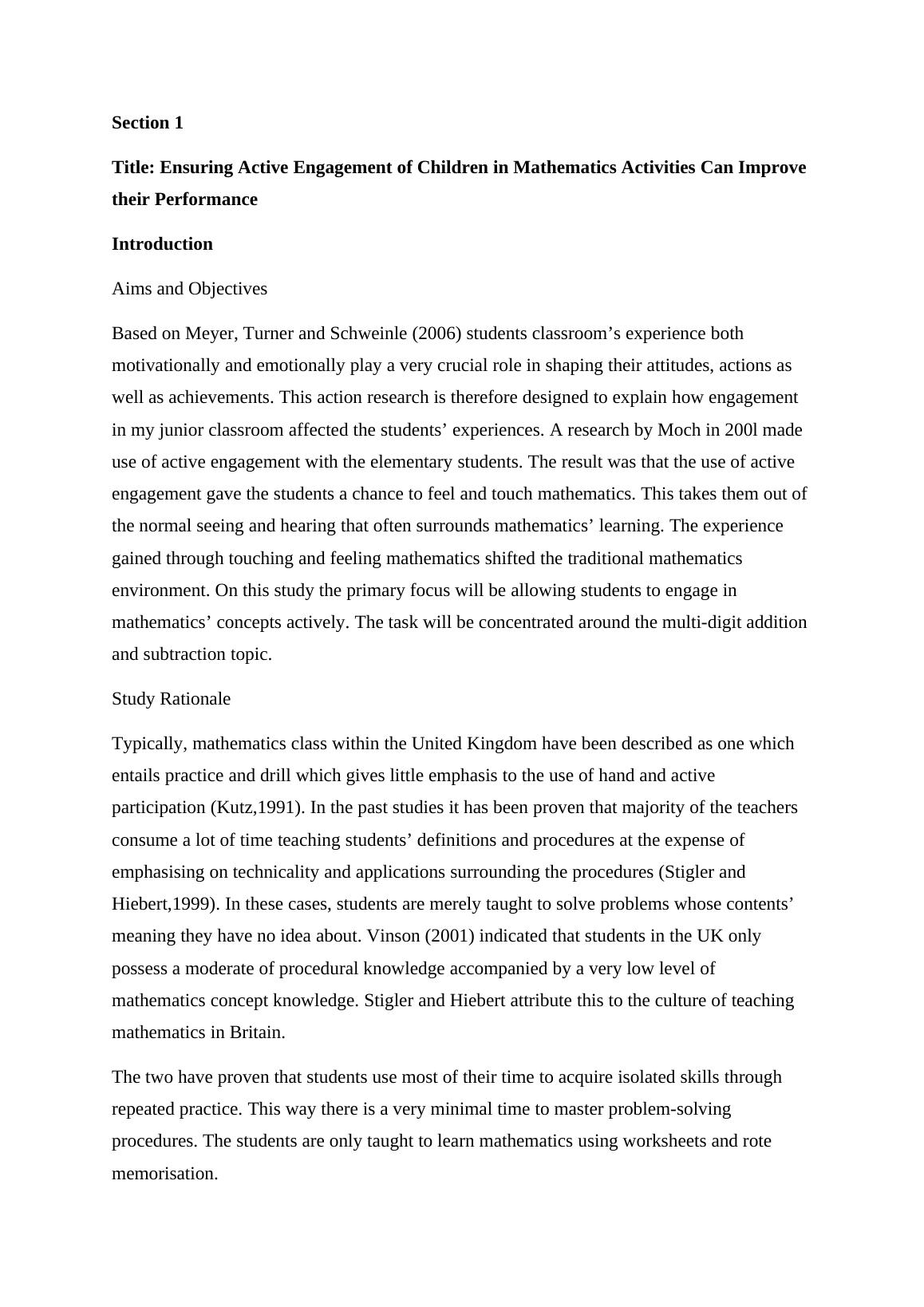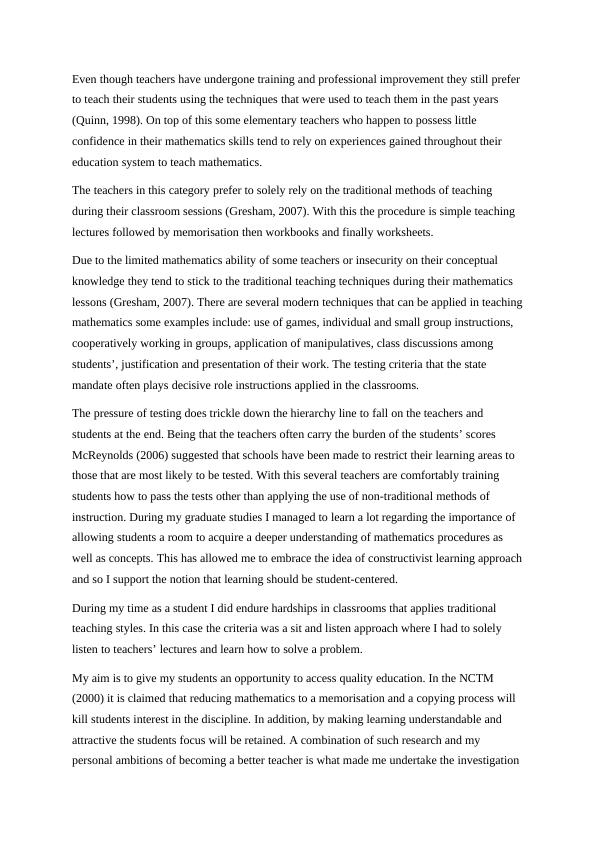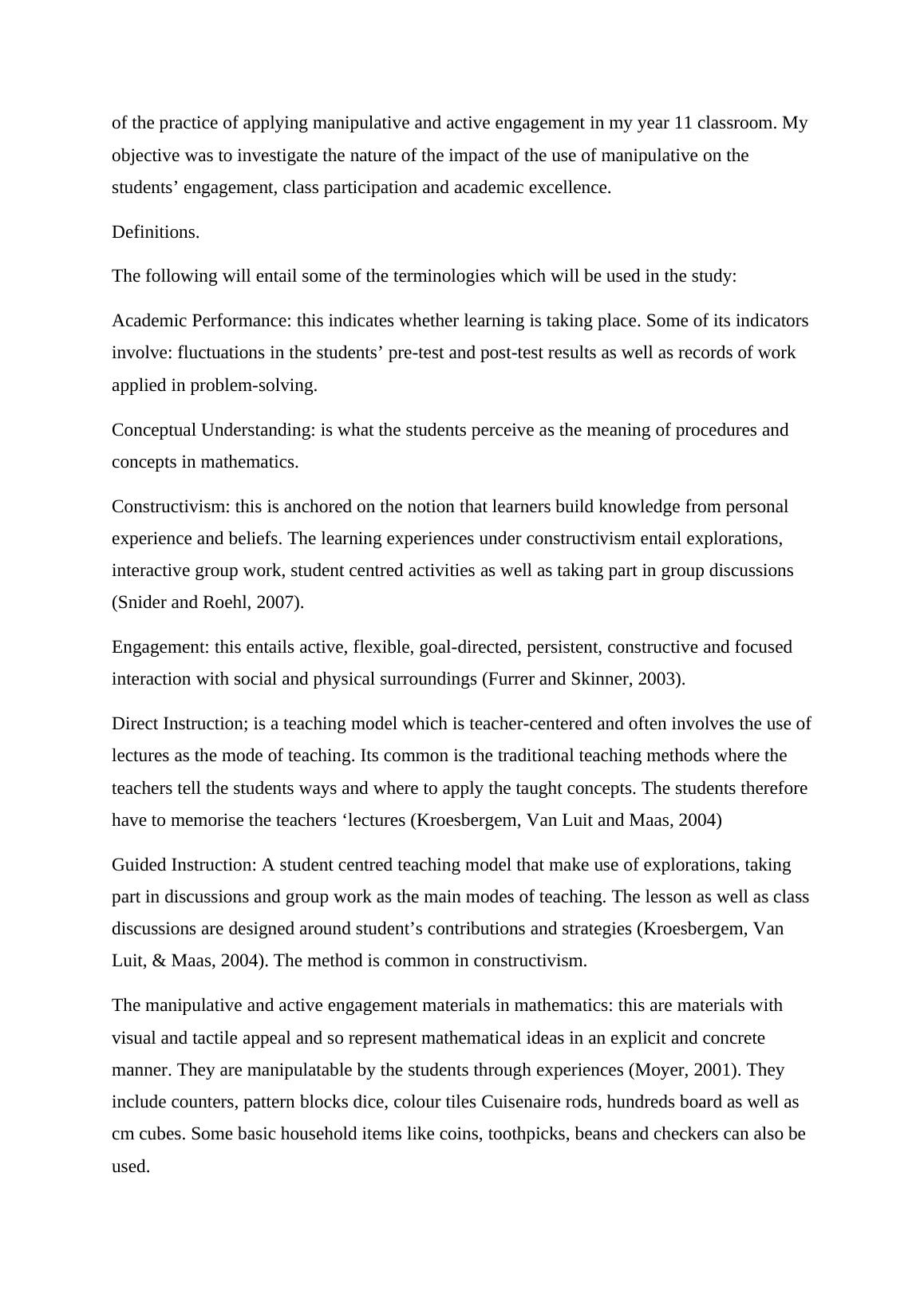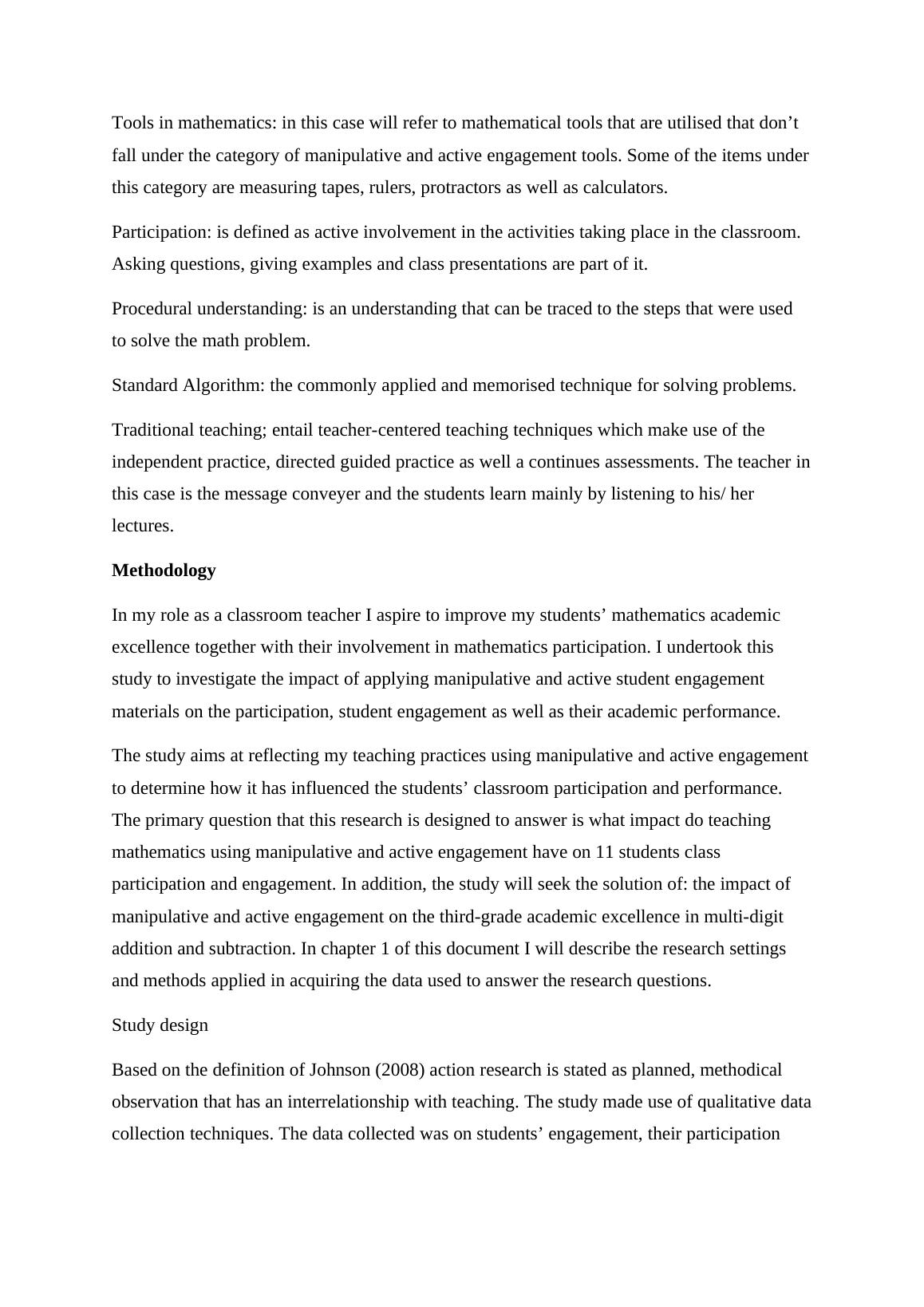The Traditional Mathematics Environment Doc
Added on 2021-06-17
15 Pages5897 Words124 Views
Section 1Title: Ensuring Active Engagement of Children in Mathematics Activities Can Improve their PerformanceIntroductionAims and ObjectivesBased on Meyer, Turner and Schweinle (2006) students classroom’s experience both motivationally and emotionally play a very crucial role in shaping their attitudes, actions as well as achievements. This action research is therefore designed to explain how engagement in my junior classroom affected the students’ experiences. A research by Moch in 200l made use of active engagement with the elementary students. The result was that the use of active engagement gave the students a chance to feel and touch mathematics. This takes them out ofthe normal seeing and hearing that often surrounds mathematics’ learning. The experience gained through touching and feeling mathematics shifted the traditional mathematics environment. On this study the primary focus will be allowing students to engage in mathematics’ concepts actively. The task will be concentrated around the multi-digit additionand subtraction topic.Study RationaleTypically, mathematics class within the United Kingdom have been described as one which entails practice and drill which gives little emphasis to the use of hand and active participation (Kutz,1991). In the past studies it has been proven that majority of the teachers consume a lot of time teaching students’ definitions and procedures at the expense of emphasising on technicality and applications surrounding the procedures (Stigler and Hiebert,1999). In these cases, students are merely taught to solve problems whose contents’ meaning they have no idea about. Vinson (2001) indicated that students in the UK only possess a moderate of procedural knowledge accompanied by a very low level of mathematics concept knowledge. Stigler and Hiebert attribute this to the culture of teaching mathematics in Britain.The two have proven that students use most of their time to acquire isolated skills through repeated practice. This way there is a very minimal time to master problem-solving procedures. The students are only taught to learn mathematics using worksheets and rote memorisation.

Even though teachers have undergone training and professional improvement they still prefer to teach their students using the techniques that were used to teach them in the past years (Quinn, 1998). On top of this some elementary teachers who happen to possess little confidence in their mathematics skills tend to rely on experiences gained throughout their education system to teach mathematics.The teachers in this category prefer to solely rely on the traditional methods of teaching during their classroom sessions (Gresham, 2007). With this the procedure is simple teaching lectures followed by memorisation then workbooks and finally worksheets.Due to the limited mathematics ability of some teachers or insecurity on their conceptual knowledge they tend to stick to the traditional teaching techniques during their mathematics lessons (Gresham, 2007). There are several modern techniques that can be applied in teachingmathematics some examples include: use of games, individual and small group instructions, cooperatively working in groups, application of manipulatives, class discussions among students’, justification and presentation of their work. The testing criteria that the state mandate often plays decisive role instructions applied in the classrooms.The pressure of testing does trickle down the hierarchy line to fall on the teachers and students at the end. Being that the teachers often carry the burden of the students’ scores McReynolds (2006) suggested that schools have been made to restrict their learning areas to those that are most likely to be tested. With this several teachers are comfortably training students how to pass the tests other than applying the use of non-traditional methods of instruction. During my graduate studies I managed to learn a lot regarding the importance of allowing students a room to acquire a deeper understanding of mathematics procedures as well as concepts. This has allowed me to embrace the idea of constructivist learning approachand so I support the notion that learning should be student-centered.During my time as a student I did endure hardships in classrooms that applies traditional teaching styles. In this case the criteria was a sit and listen approach where I had to solely listen to teachers’ lectures and learn how to solve a problem.My aim is to give my students an opportunity to access quality education. In the NCTM (2000) it is claimed that reducing mathematics to a memorisation and a copying process will kill students interest in the discipline. In addition, by making learning understandable and attractive the students focus will be retained. A combination of such research and my personal ambitions of becoming a better teacher is what made me undertake the investigation

of the practice of applying manipulative and active engagement in my year 11 classroom. Myobjective was to investigate the nature of the impact of the use of manipulative on the students’ engagement, class participation and academic excellence.Definitions.The following will entail some of the terminologies which will be used in the study:Academic Performance: this indicates whether learning is taking place. Some of its indicatorsinvolve: fluctuations in the students’ pre-test and post-test results as well as records of work applied in problem-solving.Conceptual Understanding: is what the students perceive as the meaning of procedures and concepts in mathematics.Constructivism: this is anchored on the notion that learners build knowledge from personal experience and beliefs. The learning experiences under constructivism entail explorations, interactive group work, student centred activities as well as taking part in group discussions (Snider and Roehl, 2007).Engagement: this entails active, flexible, goal-directed, persistent, constructive and focused interaction with social and physical surroundings (Furrer and Skinner, 2003).Direct Instruction; is a teaching model which is teacher-centered and often involves the use oflectures as the mode of teaching. Its common is the traditional teaching methods where the teachers tell the students ways and where to apply the taught concepts. The students thereforehave to memorise the teachers ‘lectures (Kroesbergem, Van Luit and Maas, 2004)Guided Instruction: A student centred teaching model that make use of explorations, taking part in discussions and group work as the main modes of teaching. The lesson as well as classdiscussions are designed around student’s contributions and strategies (Kroesbergem, Van Luit, & Maas, 2004). The method is common in constructivism.The manipulative and active engagement materials in mathematics: this are materials with visual and tactile appeal and so represent mathematical ideas in an explicit and concrete manner. They are manipulatable by the students through experiences (Moyer, 2001). They include counters, pattern blocks dice, colour tiles Cuisenaire rods, hundreds board as well as cm cubes. Some basic household items like coins, toothpicks, beans and checkers can also be used.

Tools in mathematics: in this case will refer to mathematical tools that are utilised that don’t fall under the category of manipulative and active engagement tools. Some of the items underthis category are measuring tapes, rulers, protractors as well as calculators.Participation: is defined as active involvement in the activities taking place in the classroom. Asking questions, giving examples and class presentations are part of it.Procedural understanding: is an understanding that can be traced to the steps that were used to solve the math problem.Standard Algorithm: the commonly applied and memorised technique for solving problems.Traditional teaching; entail teacher-centered teaching techniques which make use of the independent practice, directed guided practice as well a continues assessments. The teacher inthis case is the message conveyer and the students learn mainly by listening to his/ her lectures.MethodologyIn my role as a classroom teacher I aspire to improve my students’ mathematics academic excellence together with their involvement in mathematics participation. I undertook this study to investigate the impact of applying manipulative and active student engagement materials on the participation, student engagement as well as their academic performance.The study aims at reflecting my teaching practices using manipulative and active engagementto determine how it has influenced the students’ classroom participation and performance. The primary question that this research is designed to answer is what impact do teaching mathematics using manipulative and active engagement have on 11 students class participation and engagement. In addition, the study will seek the solution of: the impact of manipulative and active engagement on the third-grade academic excellence in multi-digit addition and subtraction. In chapter 1 of this document I will describe the research settings and methods applied in acquiring the data used to answer the research questions.Study designBased on the definition of Johnson (2008) action research is stated as planned, methodical observation that has an interrelationship with teaching. The study made use of qualitative datacollection techniques. The data collected was on students’ engagement, their participation

End of preview
Want to access all the pages? Upload your documents or become a member.
Related Documents
Utilization of Resources for Teaching Practice Analyze 2022lg...
|22
|5400
|25
Curriculum for Fostering the Learninglg...
|5
|1022
|20
